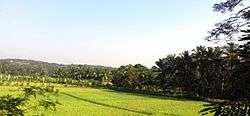Pallippuram, Palakkad
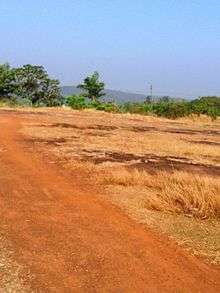
| Pallippuram പളളിപ്പുറം | |
|---|---|
| Village | |
|
Pallippuram paddy fields | |
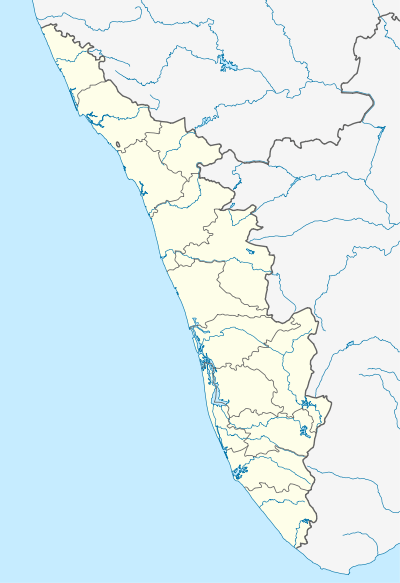 Pallippuram  Pallippuram Location in Kerala, India | |
| Coordinates: 10°50′26″N 76°06′43″E / 10.84057°N 76.11183°ECoordinates: 10°50′26″N 76°06′43″E / 10.84057°N 76.11183°E | |
| Country |
|
| State | Kerala |
| District | Palakkad |
| Area | |
| • Total | 20.71 km2 (8.00 sq mi) |
| Elevation | 14.83 m (48.65 ft) |
| Population | |
| • Total | 21,809 (2,001) |
| • Density | 1,053/km2 (2,730/sq mi) |
| Languages | |
| • Official | Malayalam, English |
| Time zone | IST (UTC+5:30) |
| PIN | 679 305 |
| Telephone code | 91466 |
| Vehicle registration | KL-52 |
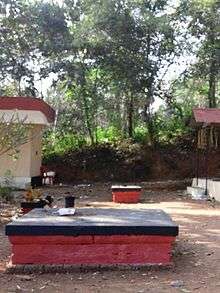
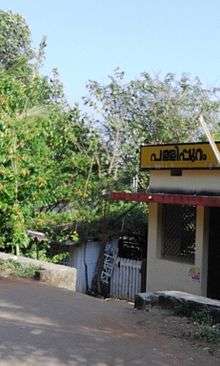
Pallippuram (![]() pronunciation ) is a village near Pattambi, Kerala, India. Situated in the western extremity ('the western horn') of Palakkad District, it is 9 kilometres north-west of Pattambi, a bigger town of the district. Part of the greater Paruthur Gramapanchayat, this place stands near the confluence of Bharathapuza River (Nila) and Tutha River (Tuthapuzha), and is bounded by these rivers to the south and west respectively. The adjacent villages to Pallippuram are Muthuthala, Thiruvegappura, Irimbiliyam, Anakkara, Pattithara, and Thrithala.
pronunciation ) is a village near Pattambi, Kerala, India. Situated in the western extremity ('the western horn') of Palakkad District, it is 9 kilometres north-west of Pattambi, a bigger town of the district. Part of the greater Paruthur Gramapanchayat, this place stands near the confluence of Bharathapuza River (Nila) and Tutha River (Tuthapuzha), and is bounded by these rivers to the south and west respectively. The adjacent villages to Pallippuram are Muthuthala, Thiruvegappura, Irimbiliyam, Anakkara, Pattithara, and Thrithala.
History
Buddhism was once prevalent in Kerala. A Buddhist place of worship, the vihara, was popularly called palli in Malayalam language and several Pallippurams emerged in the geographic dominion. The Gramapanchayat is named Parudur because of the existence of several other Pallippurams in the state. Once Pallippuram was part of the "reconstituted" Valluvanad Taluk. At another point in time before that, it was also part of Nedunganad. This was when Nedunganad was under King Zamorins of Calicut (Samoothiri). During the British colonial era, this village belonged to the Ponnani taluk of the British Malabar District. On 1 January 1962, the Cherukudangad and Parudur amsams (an amsam is the smaller denomination of village administration) were merged to form today's Parudur gram panchayat.
Climate
This place has by and large the same climatic conditions prevalent elsewhere the state: a dry season from December through February, a hot season from March through May; the Southwest Monsoon from June through September and the North East Monsoon from October through November. The South West Monsoon is usually very heavy and is responsible for nearly 75% of the annual rainfall. The dry season is generally hot and humid, with temperature varying between 20 °C and 30 °C. The average annual rainfall is 2800 mm.
Demography
This village has a population of 21,809 people, where 10,536 are males and 11,273 females as of 2001 India census,.[1] The population density is high at 1,053 persons per km². Muslims comprise approximately 65 per cent of the population, and Hindus the rest. The birth rate is 246 and death rate is 5.9 per annum. 88.65% of the population is literate (males: 90.24; females: 83.38).

This Gramapanchayat might be one of the few areas in Kerala where not even a single Christian is a permanent resident.
Recent history
A major railroad project undertaken by the erstwhile South Indian Railway, the precursor to the present Southern Railway, is the 905-km (562 mile) long Madras (now Chennai)-Mangalore line. On the 23 September 1861, the first steam locomotive train pulled into the newly built Pallippuram railway station.
The rail link heralded the establishment of a post office in Pallippuram, and anchal (post) was hand-delivered from here to nearby places.
Near Mudappakkad still stands a weather-beaten lamp-post, believed to have been built by Perumthachan, the mythical Malayali master carpenter and architect who is the stuff of many apocryphal legends.
The village was earlier ruled by the Zamorins of Calicut. In Palathara, the remnants of an old kovilakam (a small feudal mansion) from where the Zamorin-appointed revenue officials used to preside over village governance can still be seen. When the royals visited the Kodikkunnu temple, they were taken on a royal procession from Vedithara (near Palathara) to the temple in great pomp and style, escorted by the Panikkers (royal soldiers) of Paadathuveedu clan. The Panikkers of Karambathur Madom were the trusted officers (padanayars) of the Zamorin’s Royal Army. The trustees of Kodikkunnu and Chirankara temples are appointed by the Zamorin, even to this day. The revenue officials of Parudur amsam were the adhikaris (village officers) of Manjapra family and that of Cherukudangad was adhikaris of Kochi family. The granite pillars (athani) standing in Vedithara, Ambatparamb, Mangalam and Mudappakkad hark bark to the royal rule of yore.
Pallippuram once was part of the "reconstituted" Valluvanad Taluk. At another point in time before that, it was a part of Nedunganad. This was when Nedunganad was under Zamorins kings of Calicut.
The village has a rich history of a bell metal (four parts copper and one part tin) manufacture which was acclaimed even outside Kerala. The metal work industry produced bell metal deities of the Hindu iconographic pantheon. Also manufactured were temple lamps that were well known and much sought after. However, this traditional industry has almost disappeared now. The village held its weekly fair on Thursdays in Palathara that used to be the unofficial shopping festival of the entire village. The fair breathed its last in the mid-1950s.
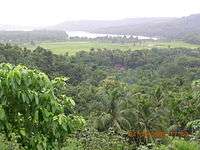
Kumarampulakkal Mana in Pallippuram and Moothedathu mana in Parudur (Now Moothedathu mana extinct and is merged with Kumarampulakkal Mana) are the most famous Hindu Brahmin families in Pallippuram.They were the old rulers of the village.
Education
Pallippuram was an important centre of Sanskrit education in Malabar. Kumarampulakal Narayanan Namboothiri ran a school at his residence dedicated to Sanskrit and Veda studies. The scholar also held numerous Sanskrit manuscripts in his private library. The pioneer in the field of modern education in the village was Chellu Ezhuthachan, who succeeded in converting the Kudippallikoodam (crude basic school, presided by a Gurunathan, the master) situated in Mangalam into an independent government-aided elementary school. He eventually went on to establish schools in Palathara, Pallippuram and Karambathur. Cutting across the caste divide, these institutions were open to all students, a revolutionary idea in Ezhuthachan's day. He even established a Muslim school in Palathara and funded the “mullah” (a teacher of Islamic theology) who ran it. Cholapparambil Achuthan Ezhuthachan and Pazhayangadi KK Ramankutty Ezhuthachan were the other noted personalities in the sphere of education in the early days.
Presently this village has many government-run/government-aided schools up to higher secondary level. They are: Parudur Higher Secondary School at Nadaparamb; GLP School at Parudur; CEUP School at Pazhayangadi; AUP School at Karambathur; GMLP School at Kariyannur; GUP School at Kodumunda; CELP School at Pallippuram; SVA LP School at Chembulangad and ALP School at Kulamukku. Besides these the village has a number of Muslim religious schools called "Madrassa".
Since 1985, the village has witnessed the establishment of a few unaided English-medium lower primary schools too.
The nearby colleges are Government Sanskrit College at Pattambi, MES College at Valanchery and MES College of Engineering at Kuttippuram.
Freedom Struggle
India’s Freedom Struggle raging across the country post World War I created ripples in this village too. The launching in 1921 of the Khilafat Movement come from Mannarkkad had a significant impact in the village too, fortunately, sans any violence and many Muslims of the village served long terms of imprisonment in various jails throughout South India. With the suppression and the eventual demise of the Movement, the village saw the strengthening of the nationalist sentiments. The youth of Chayillath Rayikulath Tharavad (upper-caste Hindu extended family) spearheaded the fight against the British colonial rule in the village, against sheer opposition from even within the family. CR Achuthankutty Nambiar and CR Balakrishnan Nambiar assumed leadership of the movement. CR Achuthankutty Nambiar was a Retired Head master from the Kulamukku school in Pallipuram who was an prominent leader in Indian National Congress. His sister, CR Devaki Amma became one of the early organisers of Mahilasangam, an associate organisation of the Indian National Congress.CR Achuthankutty Nambiar and CR Narayanan Nambiar of this family participated in the Salt Satyagraha in 1930, and spent an 18-month term in jail with K Kelappan. CR Narayanan Nambiar made major forays into the literary arena as well, and his single most notable achievement was the translation of K Damodaran’s work Indiayude Athmave (The Soul of India) into English. CR Devaki Amma led a campaign against ‘Mrigabali’ (the ritual slaughter of animals) in the nearby Muthassiar Temple, leading into the eventual disbanding of the custom. She served an 18-month jail term during the Salt Satyagraha along with her brothers and continued her crusade against the British rule after her release too. Among these freedom fighter's of the Chayillath Rayikulath Tharavadonly CR Achuthankutty Nambiar received the TAMRA PATRAM from the government of India.Devaki Amma, who died in 1996, was married to Padmanabhan Nambiar (the elder brother of veteran Communist leader, AK Gopalan). Women’s movement also caught the imagination of the village in the early 1940s, and K Madhavi Amma was instrumental in forming the first mahilasamajam (women's club and co-operative) in the village.
C Rajagopalachari visited the village in 1932 and addressed a gathering in Kodikkunnu. His mission was to garner support of the upper caste Hindus in the upcoming referendum on admittance of lower caste Hindus into the Hindu temples of Malabar. Muhammad Abdurahiman Sahib was also in attendance. The year 1939 saw Kasturba Gandhi and Urmila Ben come calling the village and attending a public meeting near Mudappakkad. When Congress Socialist Party was formed in the later years of the freedom struggle as an offshoot of the Indian National Congress, several political lights of the village, like Manjapra Appukunja Menon, joined it. This clan later founded Muhammad Abdurahiman Sahib Memorial Library in Kodikkunnu.
After India gained independence in 1947, Pallippuram continued its resistance against true-blue feudalism and casteism. Communists earned a victory in the election to the Malabar District Board in 1952. The ‘Eviction Barring Ordinance’ in 1957 by the EMS Namboodiripad-led Communist Government of Kerala naturally invited the ire of the village's feudal landlords. Yet, anti-feudalism vibes only strengthened with the successful implementation of the ordinance.
Culture
The major temples of the village are Kodikkunnu Bhagavathy Temple and Sri Krishna Temple.
The temple festival of Kodikkunnu Bhagavathy (കൊടിക്കുന്നത്തമ്മ) is conducted at Chirankara Temple which is known as the “Keezhekkavu” (alternate sanctorum) of the former. The festival is called “Chirankara Pooram” (ചിരങ്കര പൂരം) (annual harvest festival). The village is divided into 13 desoms (a desom is a geographical unit in village administration bigger than an amsam)and it is incumbent upon each desom to dispatch at least one pair of Poothan and Thira ”(തറ, പൂതന്) ” (traditional mask dancers) for performance at the temple during the festival. The 13 desoms are: Mangalam, Kodanthur, Pazhayangadi, Parudur, Kariyannur, Karambathur, Cherukudangad, Chembulangad, Kannad, Kodumunda, Pallippuram, Kulamukku and Mudappakkad. This is by and large the chief festival of the village, with the whole village participating. The village also has a number of Muslim mosques. Kodanthur mosque Nercha(നേര്ച്ച) (the annual feast and festival) is famous.
Transportation
A new bridge is built over the Bharathappuzha that connects Pallippuram and Trithala called Velliyamkallu regulator-cum-bridge. The regulator-cum-bridge was officially opened for road traffic on 2 September 2007, and is the largest such project over Bharathappuzha. A river-water regulator is also an integral part of the Velliamkallu project. When operational, this regulator is expected to help irrigate the region’s agricultural areas, which often lacks proper water supply.
The construction of an additional platform and new station building at Pallippuram Railway Station has been completed. This was done in connection with the introduction of double track of railway between Mangalore and Shoranur. Although there are many places having the name 'Pallippuram' in India, this is the only one with a Railway Station. Railway is considering Pallippuram also to make a shortcut to Kochi side via Guruvayur. If the Pallippuram-Guruvayur railway line comes to existence, Pallippuram will be a major station and junction in the railway map and that will be a boost to the village.
Important Landmarks
- Oduparakkunnu Hills
- Paruthoor Paddyfields, many films were shot here
- Kodikkunnu Temple
References
- ↑ "Census of India 2001: Data from the 2001 Census, including cities, villages and towns (Provisional)". Census Commission of India. Archived from the original on 2004-06-16. Retrieved 2008-11-01.
External links
| Wikimedia Commons has media related to Pallippuram, Palakkad. |
